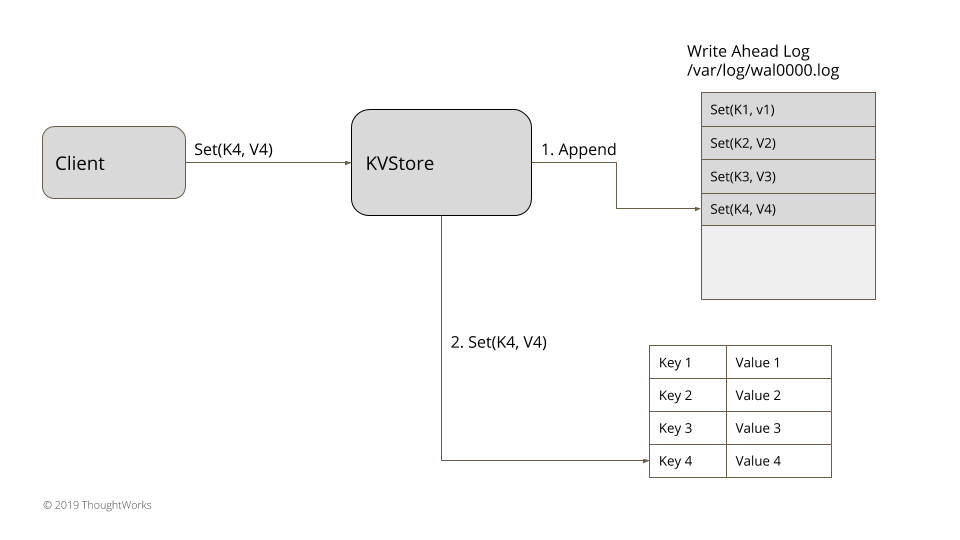预写日志(Write-Ahead Log)
原文
https://martinfowler.com/articles/patterns-of-distributed-systems/wal.html
将每个状态变化以命令形式持久化至只追加的日志中,提供持久化保证,而无需以存储数据结构存储到磁盘上。
2020.8.12
也称:提交日志
问题
对服务器而言,即便在机器存储数据失败的情况下,也要保证强持久化,这一点是必需的。一旦服务器同意执行某个动作,即便服务器失效,重启后丢失了所有内存状态,它也应该做到保证执行。
解决方案

将每个状态变化以命令的形式存储在磁盘文件中。一个日志由一个服务端进程维护,其只进行顺序追加。一个顺序追加的日志,简化了重启时以及后续在线操作(新命令追加至日志时)的日志处理。每个日志条目都有一个唯一的标识符。唯一的日志标识符有助于在日志中实现某些其它操作,比如分段日志(Segmented Log),或是以低水位标记(Low-Water Mark)清理日志等等。日志的更新可以通过单一更新队列(Singular Update Queue)实现。
典型的日志条目结构如下所示:
class WALEntry…
private final Long entryId;
private final byte[] data;
private final EntryType entryType;
private long timeStamp;每次重启时,可以读取这个文件,然后,重放所有的日志条目就可以恢复状态。
考虑下面这个简单的内存键值存储:
class KVStore…
private Map<String, String> kv = new HashMap<>();
public String get(String key) {
return kv.get(key);
}
public void put(String key, String value) {
appendLog(key, value);
kv.put(key, value);
}
private Long appendLog(String key, String value) {
return wal.writeEntry(new SetValueCommand(key, value).serialize());
}put 操作表示成了命令(Command),在更新内存的哈希表 之前先把它序列化,然后存储到日志里。
class SetValueCommand…
final String key;
final String value;
final String attachLease;
public SetValueCommand(String key, String value) {
this(key, value, "");
}
public SetValueCommand(String key, String value, String attachLease) {
this.key = key;
this.value = value;
this.attachLease = attachLease;
}
@Override
public void serialize(DataOutputStream os) throws IOException {
os.writeInt(Command.SetValueType);
os.writeUTF(key);
os.writeUTF(value);
os.writeUTF(attachLease);
}
public static SetValueCommand deserialize(InputStream is) {
try {
DataInputStream dataInputStream = new DataInputStream(is);
return new SetValueCommand(dataInputStream.readUTF(), dataInputStream.readUTF(), dataInputStream.readUTF());
} catch (IOException e) {
throw new RuntimeException(e);
}
}这就保证了一旦 put 方法返回成功,即便负责 KVStore 的进程崩溃了,启动时,通过读取日志文件也可以将状态恢复回来。
class KVStore…
public KVStore(Config config) {
this.config = config;
this.wal = WriteAheadLog.openWAL(config);
this.applyLog();
}
public void applyLog() {
List<WALEntry> walEntries = wal.readAll();
applyEntries(walEntries);
}
private void applyEntries(List<WALEntry> walEntries) {
for (WALEntry walEntry : walEntries) {
Command command = deserialize(walEntry);
if (command instanceof SetValueCommand) {
SetValueCommand setValueCommand = (SetValueCommand)command;
kv.put(setValueCommand.key, setValueCommand.value);
}
}
}
public void initialiseFromSnapshot(SnapShot snapShot) {
kv.putAll(snapShot.deserializeState());
}实现考量
实现日志还有一些重要的考量。有一点很重要,就是确保写入日志文件的日志条目已经实际地持久化到物理介质上。所有程序设计语言的文件处理程序库都提供了一个机制,强制操作系统将文件的变化“刷(flush)”到物理介质上。然而,使用这种机制有一个需要考量的权衡点。
将每个日志的写入都刷到磁盘,这种做法是给了我们一种强持久化的保证(这是使用日志的首要目的),但是,这种做法严重限制了性能,可能很快就会变成瓶颈。将刷的动作延迟,或是采用异步处理,性能就可以提高,但服务器崩溃时,日志条目没有刷到磁盘上,就存在丢失日志条目的风险。大多数采用的技术类似于批处理,以此限制刷操作的影响。
还有一个考量,就是如果日志文件受损,读取日志的时候,要保证能够检测出来,日志条目一般来说都会采用 CRC 的方式记录,这样,读取文件时可以对其进行校验。
单独的日志文件可能会变得难于管理,可能会快速地消耗掉所有的存储。为了处理这个问题,可以采用像分段日志(Segmented Log)和低水位标记(Low-Water Mark)这样的技术。
预写日志是只追加的。因为这种行为,在客户端通信失败重试的时候,日志可能会包含重复的条目。应用这些日志条目时,需要确保重复可以忽略。如果最终状态是类似于 HashMap 的东西,也就是对同一个键值的更新是幂等的,那就不需要特殊的机制。否则,就需要一些机制,对于有唯一标识符的每个请求进行标记,检测重复。
